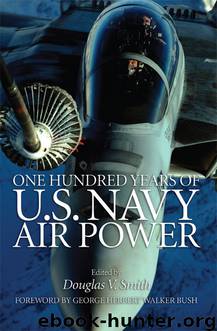One Hundred Years of U.S. Navy Air Power by Smith Douglas V

Author:Smith, Douglas V. [Smith, Douglas V.]
Language: eng
Format: epub
ISBN: 9781612514239
Publisher: Naval Institute Press
Published: 0101-01-01T00:00:00+00:00
TRANSITION
The period through 1945 produced a particular type of carrier for both strategic and technological reasons. The strategic reason was that, through this period, the U.S. Navy was designed to seize and then exploit sea control. It was therefore conceived much more to attack an enemy navy—the Imperial Japanese Navy—than to strike at land targets. Aircraft were shaped by that requirement. It was entirely reasonable to expect a dive- or torpedo bomber to take off within the 400-foot length available forward of parked aircraft. U.S. naval aircraft were expected to attack some land targets, particularly when supporting Marines going ashore, but that was very much a secondary role. Perhaps it should be added that even after the Royal Navy regained direct control of its fleet air arm in 1939, it still had to avoid encroaching on the land attack role espoused by the Royal Air Force; there really was a distinct U.S. Navy view of the role of naval aviation. That view would become very important after 1945. In 1945, all existing U.S. naval aircraft could operate from all existing carriers. By 1945 the U.S. Navy was interested in larger carrier aircraft, such as the twin-engine Grumman F7F Tigercat, which would not have been able to operate from small carriers; but it was still true that carrier dimensions and speed shaped naval aircraft, not the other way around. It is not, incidentally, true that some aircraft, such as the Tigercat, were conceived specifically to operate from the big Midways—they had not yet been designed when the aircraft specifications were laid out.
The foundation built between the wars made it possible for the U.S. Navy to shift toward a carrier-centered World War II fleet. The huge prewar U.S. naval air establishment was relatively easy to expand to train tens of thousands of new pilots and other personnel. It also trained the senior officers to command a much-expanded carrier fleet. In 1941 the U.S. Navy had seven fleet carriers and one escort carrier. By the end of the war, the U.S. Navy had over a hundred carriers (although most were quick and relatively inefficient conversions of merchant ship and cruiser hulls).
By the time the Imperial Japanese Navy was essentially gone, in 1945, the U.S. Navy had become interested in a new mission, strategic air attack. It was not entirely new: prewar fleet exercises did show valuable potentials for supporting amphibious landings and for attacking enemy shore installations (the U.S. carriers often raided the Panama Canal, Pearl Harbor, and Los Angeles), but they were secondary.
That year the U.S. naval staff studied the contribution that carrier aircraft could make to the bomber attack on Japan by B-29s. It concluded that given the sheer number of carrier aircraft, and the short ranges from which they could be launched, carrier bombers could deliver up to 60 percent of the tonnage available from B-29s. Against this calculation, a January 1945 carrier raid on Tokyo was less than successful, the small carrier bombers finding the high winds over Japan
Download
This site does not store any files on its server. We only index and link to content provided by other sites. Please contact the content providers to delete copyright contents if any and email us, we'll remove relevant links or contents immediately.
The Radium Girls by Kate Moore(10929)
The Templars by Dan Jones(4199)
100 Deadly Skills by Clint Emerson(4095)
Rise and Kill First by Ronen Bergman(4029)
The Doomsday Machine by Daniel Ellsberg(3743)
The Rape of Nanking by Iris Chang(3531)
Killing England by Bill O'Reilly(3469)
Hitler in Los Angeles by Steven J. Ross(3450)
Stalin by Stephen Kotkin(3097)
12 Strong by Doug Stanton(3065)
Hitler's Monsters by Eric Kurlander(2741)
Darkest Hour by Anthony McCarten(2655)
Blood and Sand by Alex Von Tunzelmann(2616)
The Art of War Visualized by Jessica Hagy(2425)
Hitler's Flying Saucers: A Guide to German Flying Discs of the Second World War by Stevens Henry(2306)
The Code Book by Simon Singh(2223)
The Second World Wars by Victor Davis Hanson(2140)
Babylon's Ark by Lawrence Anthony(2079)
Tobruk by Peter Fitzsimons(2069)
